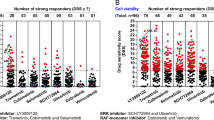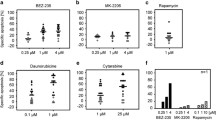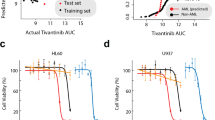Abstract
In hematological malignancies, constitutive activation of the RAF/MEK/ERK pathway is frequently observed, conveys a poor prognosis, and constitutes a promising target for therapeutic intervention. Here, we investigated the molecular and functional effects of pharmacological MEK inhibition in cell line models of acute myeloid leukemia (AML) and freshly isolated primary AML samples. The small-molecule, ATP-non-competitive, MEK inhibitor PD0325901 markedly inhibited ERK phosphorylation and growth of several AML cell lines and approximately 70 % of primary AML samples. Growth inhibition was due to G1-phase arrest and induction of apoptosis. Transformation by constitutively active upstream pathway elements (HRAS, RAF-1, and MEK) rendered FDC-P1 cells exquisitely prone to PD0325901-induced apoptosis. Gene and protein expression profiling revealed a selective effect of PD0325901 on ERK phosphorylation and compensatory upregulation of the RAF/MEK and AKT/p70S6K kinase modules, potentially mediating resistance to drug-induced growth inhibition. Consequently, in appropriate cellular contexts, both “vertical” (i.e., inhibition of RAF and MEK along the MAPK pathway) and “lateral” (i.e., simultaneous inhibition of the MEK/ERK and mTOR pathways) combination strategies may result in synergistic anti-leukemic effects. Overall, MEK inhibition exerts potent growth inhibitory and proapoptotic activity in preclinical models of AML, particularly in combination with other pathway inhibitors. Deeper understanding of the molecular mechanisms of action of MEK inhibitors will likely translate into more effective targeted strategies for the treatment of AML.





Similar content being viewed by others
References
McCubrey JA, Steelman LS, Chappell WH, Abrams SL, Wong EW, Chang F, Lehmann B, Terrian DM, Milella M, Tafuri A et al (2007) Roles of the Raf/MEK/ERK pathway in cell growth, malignant transformation and drug resistance. Biochim Biophys Acta 1773:1263–1284
Sebolt-Leopold JS, Herrera R (2004) Targeting the mitogen-activated protein kinase cascade to treat cancer. Nat Rev Cancer 4:937–947
Gregorj C, Ricciardi MR, Petrucci MT, Scerpa MC, De Cave F, Fazi P, Vignetti M, Vitale A, Mancini M, Cimino G et al (2007) ERK1/2 phosphorylation is an independent predictor of complete remission in newly diagnosed adult acute lymphoblastic leukemia. Blood 109:5473–5476
Kornblau SM, Womble M, Qiu YH, Jackson CE, Chen W, Konopleva M, Estey EH, Andreeff M (2006) Simultaneous activation of multiple signal transduction pathways confers poor prognosis in acute myelogenous leukemia. Blood 108:2358–2365
Milella M, Precupanu CM, Gregorj C, Ricciardi MR, Petrucci MT, Kornblau SM, Tafuri A, Andreeff M (2005) Beyond single pathway inhibition: MEK inhibitors as a platform for the development of pharmacological combinations with synergistic anti-leukemic effects. Curr Pharm Des 11:2779–2795
Lauchle JO, Kim D, Le DT, Akagi K, Crone M, Krisman K, Warner K, Bonifas JM, Li Q, Coakley KM et al (2009) Response and resistance to MEK inhibition in leukaemias initiated by hyperactive Ras. Nature 461:411–414
Milella M, Kornblau SM, Estrov Z, Carter BZ, Lapillonne H, Harris D, Konopleva M, Zhao S, Estey E, Andreeff M (2001) Therapeutic targeting of the MEK/MAPK signal transduction module in acute myeloid leukemia. J Clin Invest 108:851–859
Milella M, Estrov Z, Kornblau SM, Carter BZ, Konopleva M, Tari A, Schober WD, Harris D, Leysath CE, Lopez-Berestein G et al (2002) Synergistic induction of apoptosis by simultaneous disruption of the Bcl-2 and MEK/MAPK pathways in acute myelogenous leukemia. Blood 99:3461–3464
Milella M, Konopleva M, Precupanu CM, Tabe Y, Ricciardi MR, Gregorj C, Collins SJ, Carter BZ, D’Angelo C, Petrucci MT et al (2007) MEK blockade converts AML differentiating response to retinoids into extensive apoptosis. Blood 109:2121–2129
Lunghi P, Costanzo A, Salvatore L, Noguera N, Mazzera L, Tabilio A, Lo-Coco F, Levrero M, Bonati A (2006) MEK1 inhibition sensitizes primary acute myelogenous leukemia to arsenic trioxide-induced apoptosis. Blood 107:4549–4553
Lunghi P, Giuliani N, Mazzera L, Lombardi G, Ricca M, Corradi A, Cantoni AM, Salvatore L, Riccioni R, Costanzo A et al (2008) Targeting MEK/MAPK signal transduction module potentiates ATO-induced apoptosis in multiple myeloma cells through multiple signaling pathways. Blood 112:2450–2462
Tortora G, Bianco R, Daniele G, Ciardiello F, McCubrey JA, Ricciardi MR, Ciuffreda L, Cognetti F, Tafuri A, Milella M (2007) Overcoming resistance to molecularly targeted anticancer therapies: rational drug combinations based on EGFR and MAPK inhibition for solid tumours and haematologic malignancies. Drug Resist Updat 10:81–100
McCubrey JA, Steelman LS, Abrams SL, Bertrand FE, Ludwig DE, Basecke J, Libra M, Stivala F, Milella M, Tafuri A et al (2008) Targeting survival cascades induced by activation of Ras/Raf/MEK/ERK, PI3K/PTEN/Akt/mTOR and Jak/STAT pathways for effective leukemia therapy. Leukemia 22:708–722
McCubrey JA, Milella M, Tafuri A, Martelli AM, Lunghi P, Bonati A, Cervello M, Lee JT, Steelman LS (2008) Targeting the Raf/MEK/ERK pathway with small-molecule inhibitors. Curr Opin Investig Drugs 9:614–630
Lyubynska N, Gorman MF, Lauchle JO, Hong WX, Akutagawa JK, Shannon K, Braun BS (2011) A MEK inhibitor abrogates myeloproliferative disease in Kras mutant mice. Sci Transl Med 3:76ra27
Chou TC, Talalay P (1984) Quantitative analysis of dose–effect relationships: the combined effects of multiple drugs or enzyme inhibitors. Adv Enzyme Regul 22:27–55
Blalock WL, Pearce M, Steelman LS, Franklin RA, McCarthy SA, Cherwinski H, McMahon M, McCubrey JA (2000) A conditionally-active form of MEK1 results in autocrine tranformation of human and mouse hematopoietic cells. Oncogene 19:526–536
Tai YT, Fulciniti M, Hideshima T, Song W, Leiba M, Li XF, Rumizen M, Burger P, Morrison A, Podar K et al (2007) Targeting MEK induces myeloma-cell cytotoxicity and inhibits osteoclastogenesis. Blood 110:1656–1663
Annunziata CM, Hernandez L, Davis RE, Zingone A, Lamy L, Lam LT, Hurt EM, Shaffer AL, Kuehl WM, Staudt LM (2011) A mechanistic rationale for MEK inhibitor therapy in myeloma based on blockade of MAF oncogene expression. Blood 117:2396–2404
Chambard JC, Lefloch R, Pouyssegur J, Lenormand P (2007) ERK implication in cell cycle regulation. Biochim Biophys Acta 1773:1299–1310
Ciuffreda L, Del Bufalo D, Desideri M, Di Sanza C, Stoppacciaro A, Ricciardi MR, Chiaretti S, Tavolaro S, Benassi B, Bellacosa A et al (2009) Growth-inhibitory and antiangiogenic activity of the MEK inhibitor PD0325901 in malignant melanoma with or without BRAF mutations. Neoplasia 11:720–731
Milella M, Chiaretti S, Ricciardi MR et al (2007) Comparative gene profiling of acute myeloid leukemia (AML) and malignant melanoma (MEL) cell lines exposed to the MEK inhibitor PD0325901 reveals common effectors of the MEK/ERK kinase module. Blood 110:3470, ASH Annual Meeting Abstracts
Dry JR, Pavey S, Pratilas CA, Harbron C, Runswick S, Hodgson D, Chresta C, McCormack R, Byrne N, Cockerill M et al (2010) Transcriptional pathway signatures predict MEK addiction and response to selumetinib (AZD6244). Cancer Res 70:2264–2273
Wang D, Boerner SA, Winkler JD, LoRusso PM (2007) Clinical experience of MEK inhibitors in cancer therapy. Biochim Biophys Acta 1773:1248–1255
Solit DB, Garraway LA, Pratilas CA, Sawai A, Getz G, Basso A, Ye Q, Lobo JM, She Y, Osman I et al (2006) BRAF mutation predicts sensitivity to MEK inhibition. Nature 439:358–362
Friday BB, Yu C, Dy GK, Smith PD, Wang L, Thibodeau SN, Adjei AA (2008) BRAF V600E disrupts AZD6244-induced abrogation of negative feedback pathways between extracellular signal-regulated kinase and Raf proteins. Cancer Res 68:6145–6153
Alessi DR, Cuenda A, Cohen P, Dudley DT, Saltiel AR (1995) PD 098059 is a specific inhibitor of the activation of mitogen-activated protein kinase kinase in vitro and in vivo. J Biol Chem 270:27489–27494
McKay MM, Ritt DA, Morrison DK (2009) Signaling dynamics of the KSR1 scaffold complex. Proc Natl Acad Sci USA 106:11022–11027
Nguyen TK, Jordan N, Friedberg J, Fisher RI, Dent P, Grant S (2010) Inhibition of MEK/ERK1/2 sensitizes lymphoma cells to sorafenib-induced apoptosis. Leuk Res 34:379–386
Ou DL, Shen YC, Liang JD, Liou JY, Yu SL, Fan HH, Wang DS, Lu YS, Hsu C, Cheng AL (2009) Induction of Bim expression contributes to the antitumor synergy between sorafenib and mitogen-activated protein kinase/extracellular signal-regulated kinase kinase inhibitor CI-1040 in hepatocellular carcinoma. Clin Cancer Res 15:5820–5828
Ciuffreda L, McCubrey JA, Milella M (2009) Signaling intermediates (PI3K/PTEN/AKT/mTOR and RAF/MEK/ERK pathways) as therapeutic targets for anti-cancer and anti-angiogenesis treatments. Curr Signal Transduct Ther 4:130–143
Gopal YN, Deng W, Woodman SE, Komurov K, Ram P, Smith PD, Davies MA (2010) Basal and treatment-induced activation of AKT mediates resistance to cell death by AZD6244 (ARRY-142886) in Braf-mutant human cutaneous melanoma cells. Cancer Res 70:8736–8747
Ciuffreda L, Di Sanza C, Cesta Incani U, Eramo A, Desideri M, Biagioni F, Passeri D, Falcone I, Sette G, Bergamo P et al. (2012) The mitogen-activated protein kinase (MAPK) cascade controls phosphatase and tensin homolog (PTEN) expression through multiple mechanisms. J Mol Med (Berl) doi:10.1007/s00109-011-0844-1
Ravandi F, Pigneux A, DeAngelo DJ, Dombret H, Delaunay J, Thomas X, Kadia T, Luepfert C, Asatiani E, Donica M et al (2011) Preliminary clinical, pharmacokinetic (PK) and pharmacodynamic (PD) results of the safety run-in part of a phase II trial of orally available MEK-inhibitor MSC1936369 in patients (Pts) with advanced hematological malignancies (HM). Blood 118:1554 (ASH Annual Meeting Abstracts)
Acknowledgments
The authors wish to thank Dr. Lara Felicioni (Clinical Research Center, Center of Excellence on Aging, University-Foundation, Chieti, Italy) for her contribution to the characterization of the mutational status of the cell lines employed. This work was supported in part by grants from the Italian Association for Cancer Research (AIRC, to M.M. and D.D.B.), the Italian Ministry of Health (to M.M.), and the Cariplo Foundation (to M.M.). L.C. is a fellow of the Italian Foundation for Cancer Research (FIRC). A.T. and M.M. equally contributed to this manuscript.
Disclosure statements
The authors have nothing to disclose.
Author information
Authors and Affiliations
Corresponding author
Electronic supplementary material
Below is the link to the electronic supplementary material.
ESM 1
(DOC 797 kb)
Rights and permissions
About this article
Cite this article
Ricciardi, M.R., Scerpa, M.C., Bergamo, P. et al. Therapeutic potential of MEK inhibition in acute myelogenous leukemia: rationale for “vertical” and “lateral” combination strategies. J Mol Med 90, 1133–1144 (2012). https://doi.org/10.1007/s00109-012-0886-z
Received:
Revised:
Accepted:
Published:
Issue Date:
DOI: https://doi.org/10.1007/s00109-012-0886-z




